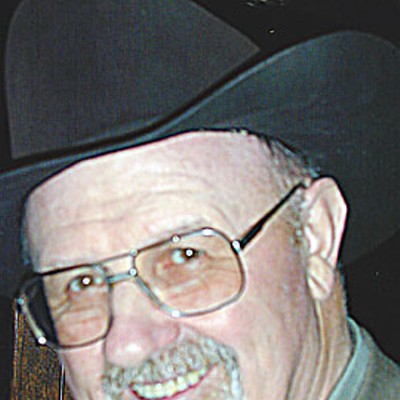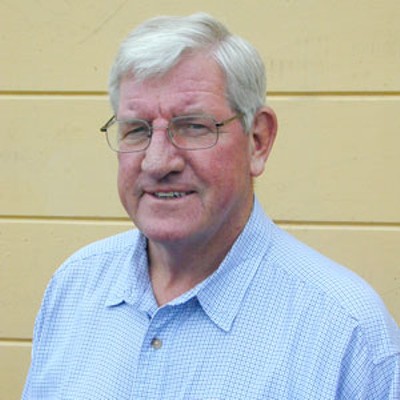Top 10 Stories of 2008
Weed, feds, fish. Fallen moguls and crooked cops. General economic panic.
By North Coast Journal Staff[
{
"name": "Top Stories Video Pair",
"insertPoint": "7",
"component": "17087298",
"parentWrapperClass": "fdn-ads-inline-content-block",
"requiredCountToDisplay": "1"
}
]
1. CRASH
Ugh, the economy ... woe is us. It's "the worst economic meltdown since the Great Depression," we're told every few minutes, and Humboldt County can no longer huddle behind the Redwood Curtain. To wit, Samoa's Evergreen Pulp Mill, which withered in a sluggish global pulp market. The mill somehow changed hands in October -- from a Chinese company to a British Virgin Islands outfit which may or may not be related -- and was shut down, leaving nearly 200 skilled laborers out of work for at least three to six months. Probably longer.
The myth that Humboldt is protected by its isolation was exploded in 2008. All of our big economic wounds -- the mills, the retail closures, the continued declines in the housing, financial and timber markets -- were largely inflicted by forces outside our misty borders. County home sales are down almost 20 percent from a year ago, manufacturing's down 19 percent and retail's down 12, according to the latest issue of the Humboldt Economic Index. And most experts agree that things will only get worse in the first quarter of 2009.
But lifting the Redwood Curtain has had its advantages, too. Ron Samuels, owner of Arcata's world-class marimba manufacturers Marimba One had a good year. More than half of the company's business is overseas, and the weak dollar helped. "That was great for us," Samuels said at a recent meeting of the Humboldt County Workforce Investment Board. The WIB's executive director, Jacqueline Debets, said Marimba One exemplifies how Humboldt's story has changed. Used to be we sank or swam on the tides of fishing and timber. As they've faded, we've diversified, creating new jobs in health care, specialty foods and niche manufacturing, among other "targets of opportunity" identified by the WIB as showing significant growth over the past 15 years. And we've done it by reaching out to the world at large.
The result? "This is the most resilient economy we've ever had," Debets said. "For the first time since timber was king, our unemployment rate is lower than the state average." At 7.5 percent (compared to the state's 8.2), it's also lower than it was during the recessions of 1973 (12.7 percent), 1980-82 (16.7 percent) and 1990-91 (8.7 percent).
For the men and women laid off from the mills, the Eureka Reporter, Mervyn's and McMahan's, to name but a few, finding new employment won't be easy. We're probably all in for tougher times ahead. Still, we held our own in 2008, not by moving toward isolationism or pining for our industrial past, but by expanding our search for opportunities and piecing together a multifaceted new identity for the 21st century.
-- Ryan Burns
2. TIMBER WAR ENDS?
As the curtain lifted on Year 2008, the harsh blaring light of Texas illuminated a tense tableau: a buncha vultures hunching about, muttering and smacking their beaks, antsy to get at the dying beast on the table. OK, the vultures were all over the country in their comfy offices, and the beast was actually dying in the redwood-Doug fir forest of Humboldt. But the man keeping them from the near-corpse -- the bankrupt Pacific Lumber Co., driven to starvation over the past 20 years by greedster Charles Hurwitz' Maxxam Corp. -- presided from a Corpus Christi bankruptcy court, because that's where Maxxam had finagled to file for bankruptcy a whole year before.
And Judge Richard S. Schmidt had set a deadline: By the end of January, anyone wanting to take over the nearly $1 billion-in-debt-laden timber company and revive it -- or sell it, or whatever, in order to pay off creditors -- had to file their plans.
After much flapping, a number of plans were filed. By April, three remained: one by PL, to sell off some of the woods and develop another large chunk; one by the timber noteholders, to auction off the 210,000 acres of timber to recoup the $700-some million owed them; and one by the largest secured creditor of the mill and town operations, Marathon Structured Finance Fund, to revive and co-run the whole shebang with Mendocino Redwood Company, the timber firm founded by the San Francisco Fisher family, they of GAP/Old Navy fame.
Curious birds dropped in along the way. Poker champ Andy Beal, holding the biggest hand of timber notes, offered to buy the timberland. Then the noteholders sidled close to timber magnate Red Emmerson, head of Sierra Pacific Industries, who offered to buy and run PL's mill and power plant. Harvard University's endowment fund also made noise about buying the land.
The unsecured creditors leaned toward Marathon, though dreamily distracted by news that a Nature Conservancy-led group wanted to buy the land, put a conservation easement on it and allow sustainable logging. Then Hurwitz himself, rather anticlimactically, said he was for Marathon-Mendo.
In June, Schmidt confirmed M and M's reorganization plan: They'd pay the noteholders $530 million, Marathon would run the town and MRC -- touted as having revived hard-logged country in Mendocino with sustainable practices -- would run the timber and mill under the new name of Humboldt Redwood Company.
By midsummer, the stage had shifted back to the woods. Cue the cheery floodlights. The company was rehiring most of the laid-off PL employees. And HRC President Mike Jani went into the woods personally to promise the treesitters occupying old-growth behemoths that henceforth no old growth would be cut.
It was as if, many will tell you, the winning vulture reached deep into the chest of the malingering beast and did the unimaginable: It gave the poor critter a new heart and then helped it back up on its feet.
-- Heidi Walters
3. THE GUNDERSEN CASE
The trial of Blue Lake Police Chief David Gundersen unfolded with a lurid sensationalism usually reserved for TV melodramas. The chief's alleged public corruption and private perversions made for tawdry theater, taking us from shocked to disturbed and leaving an icky residue of shame at our own fascination.
On the morning of Feb. 8, Sgt. Darcie Seal, Gundersen's wife and second in command of the BLPD, told investigators her husband had raped her hundreds of times since 2005 while she was unconscious under the influence of the sleep aid Lunesta and/or marijuana. He'd been taking naked pictures of her while she slept, she said, and he refused to stop. Tearfully, she told the investigators that she feared for her life. Gundersen was arrested that evening at the couple's McKinleyville home and transported to the Humboldt County Jail. He was charged with two dozen counts of spousal rape, 11 counts of battery and two felony weapons charges stemming from the vast cache of firearms seized from the BLPD, which included 27 submachine guns. Gundersen pleaded not guilty on all counts.
Things just got stranger from there. At a preliminary hearing, Gundersen's ex-wife, a Sheriff's Office employee, testified that she too had been raped by Gundersen, at gunpoint no less, while the two were together. She also said that he'd repeatedly drugged and sexually assaulted her, just like he'd done to Seal. In the wake of the trial, the BLPD collapsed. Seal resigned. The City Council terminated Gundersen's contract, then voted to disband the department altogether, leaving the small town's law enforcement to the Sheriff's Department.
Like every sordid court drama, this one had a twist: When Seal took the stand in August, she said she'd lied to investigators. Her husband never raped her, she now insisted. She was being "sarcastic" when she'd said otherwise. This whole ordeal, she claimed, was part of the ex-wife's plan to win full custody of her children. Seal wanted her husband released, and she accused law enforcement of civil rights violations, coercion, false imprisonment and conspiracy.
Her testimony instilled doubt, and the jury acquitted Gundersen of the rape charges. He was found guilty of 11 counts of battery for the naked photographs, guilty of violating a court order and guilty of two felony weapons charges, then released on bail. But the drama didn't end there. He could yet face rape charges pertaining to his ex-wife. Last month, Gundersen's lawyer filed a motion challenging 13 of the 14 convictions, and just last week Gundersen pleaded not guilty to a new charge of felony grand theft. A preliminary hearing is scheduled for Jan. 16.
-- Ryan Burns
4. KLAMATH DEALS
Oh gawd, how funny. In this dream, it isn't Doc Sarvis, George Hayduke and Seldom Seen Smith -- chief males of Ed Abbey's "progress"-dismantling crew in The Monkey Wrench Gang -- sitting around the campfire plotting to take down a dam. It's the feds, Indians, enviros, fishermen, ranchers, Oregon and California governors and the power company that owns the dams. And they're not just talking about obliterating one dam (and, alas, not Abbey's behated Glen Canyon dam), but four dams. Four.
And it's about time, say those who've watched salmon carcasses pile up on the river's banks and the ocean empty of fishing boats. Decades into this conversation, and we're finally getting somewhere. Someday, thickets of salmon may again shimmy up and down the entire length of the river like they were doing until a hundred years ago, unimpeded by concrete and slime.
But it isn't a dream. In January, after three years of talks, farmers, several tribes, fishermen, and state and federal agencies signed the Klamath Basin Restoration Agreement. The deal guarantees the farmers water -- less in dry years, more in wet -- plus cheap power and a means to develop new renewable energy once the dams come down. There'd be millions of dollars for river restoration, too, and fish would get enough water to thrive.
OK, some did shun that first deal: a couple of environmental groups, who said it favored the farmers and didn't even include a specific commitment to topple the dams; the Hoopa Valley Tribe, who called it "an Old West irrigation deal"; and the dams' owner, PacifiCorp, which wasn't even part of the negotiations toward the end.
Then in November, PacifiCorp, top tier feds and officials from California and Oregon agreed in principle to tear down four dams on the Klamath. But first there'd be a dozen years of studies to see if the deed was financially and environmentally doable. And everybody would have to raise a bundle of cash to pay for dam demolition and river restoration. There'd be legislative and legal hurdles. While many rejoiced, some holdouts cautioned that there were just too many ways out of the agreement -- why, those dams might never come down.
Even so -- the biggest foes of dam removal had actually agreed that they should come down.
-- Heidi Walters
5. NEWPAPER WAR WON
The only thing more surprising than an old-fashioned, scoop-hustlin' newspaper war being waged in the 21st Century, in a city of less than 30,000 residents, was how abruptly it ended. The pitched battle of Eureka dailies enlisted dueling millionaires, smack-talking reporters and sanctimonious opinion-page scribes, with a battlefront that spread from doorsteps and news racks to courtrooms and cyberspace. (Full disclosure: I served about a year-and-a-half in the trenches at the Times-Standard.) It wasn't until the Eureka Reporter disappeared, suddenly and almost completely, that both fans and critics paused to consider its significance -- how it had enlivened and improved local news coverage, and how it will be missed.
Popular history has it that impetuous local millionaire Rob Arkley launched the ER in a vindictive pique after the T-S refused to endorse his wife for Eureka mayor in 2002, a race she lost by fewer than 50 votes. Arkley denied those rumors but never hid his disdain for the 150-year-old T-S, which he found too liberal and lacking for local coverage. In taking on the established daily, Arkley was challenging newspaper mega-baron Dean Singleton, whose Denver-based MediaNews Group owns the T-S. It was on.
Launched online in August of 2004, the ER soon graduated to a free print edition tossed (willy-nilly, said detractors) on local doorsteps. The upstart was formidable -- a handsomely designed publication printed on high-quality newsprint using state-of-the-art equipment. But the pool of advertisers and consumers was just too small to be comfortably shared, and the battle, predictably, ended up in court. The ER won the first round in April, earning status as an "adjudicated" paper, which entitled it to print valuable legal notices just like the T-S. But the T-S took round two when a state court of appeals overturned the decision in August.
Round three looked to be a doozy, with team T-S going right at Arkley, alleging that he operated his paper at a loss with the express purpose of poaching advertisers and destroying competition. The case never saw the light of day, however. Early last month, the ER called it quits. Within days, the office was vacated, the racks emptied and the website wiped clean. Speculation flew about a closed-door agreement between the two rivals, but the only thing readers knew for sure was that the Reporter had vanished, leaving nothing but their name on a building, a token editorial page in the T-S twice a week and whatever copies could be dug up in local libraries.
-- Ryan Burns
6. POT BACKLASH
Arcata's marijuana users have been growing their own for years in the closets, garages, attics and back rooms of private homes. But in 2008, the progressive, pot-friendly city's "grow houses" hit the headlines and became a hot issue, along with Arcata's medical cannabis dispensaries. ABC News described Arcata as "Medical Marijuana's Eco Boomtown." The New York Times and the New Yorker were among those coming to take a look.
The laws regulating medical marijuana have been vague at best since the passage of Proposition 215, the "Compassionate Use Act of 1996." Growers operating under shelter of the drug's quasi-legality have made pot into a major business. Some analysts suggest it's the biggest cash crop in the county, even in the whole state. The side effects, critics complained, being a loss of housing stock to grow rooms, increased danger of fires due to jury-rigged wiring and neighborhoods taken over by clandestine operators.
As candidates for City Council offered their opinions on solutions, the Arcata Planning Commission was tackling the perceived problem, working up land-use based guidelines for household operations and the up-to-then unregulated clinics in an attempt to take what had been a gray area in the law and make it more-or-less black and white.
In August, in the midst of the city's ruminations, state Attorney General Jerry Brown published a new set of Prop. 215 guidelines, most significantly redefining so-called clinics and dispensaries as "cooperatives" and "collectives" and declaring that all must become non-profit operations.
In November the City Council signed off on the planning commission's guidelines. The new regulations take effect this Friday, Dec. 19. The new rules limit home grows to 50 square feet and with a 1,200 watts power maximum for grow-lights. Pot centers are allowed to use up to 1,500 square feet or 25 percent of their total floor space for growing. The number of cooperatives/collectives is held to the four existing businesses, with the cap dropping as low as two if current clinics cease operation. While some of the co-ops had been buying pot from members for resale, the practice in no longer allowed if the member resides within the city limits.
Indoor pot growing also came before the Humboldt County Supervisors in a recent presentation by environmentally-minded southern Humboldt residents concerned about the side-effects of large scale marijuana grows lit using diesel generators. The resistance to "diesel dope" may well become a hot topic for 2009.
-- Bob Doran
7. CODE ENFORCEMENT
In February, the composted shit hit the fan. Residents of rural southern Humboldt's Elk Ridge Road were visited by the county code enforcement unit backed by Sheriff's deputies. Residents claim the officers, guns out, wandered around unannounced and without inspection warrants, and when they encountered landowners peppered them with questions: Is the septic up to code? The house? The lumber pile?
It was weird, and scary. Residents knew that the CEU -- charged with enforcing building, health and safety codes -- had recently been on Woods Ranch Road to check out a reported diesel spill, and that Sheriff's deputies with them had ended up busting a couple of pot grows they'd encountered. The CEU had inspection warrants for those Woods Ranch visits, although they hadn't notified residents they'd be coming.
Had code inspections become guises for routing out illegal commercial pot grows? Many thought so; they'd heard about similar incidents of late. Or was the county trying to run back-to-the-landers and their funky DIYs off the land? And why the no-notice, and the guns, if they were really just out to bust unpermitted houses, illegal poopers and graywater systems dribbling onto gardens?
In early April, 600 people crammed a meeting held by the Civil Liberties Monitoring Project. Hundreds also went to a Board of Supervisors meeting four days later. The CEU was a mess and people were afraid of it, and the county's increased spotlight on code violations had stirred up unresolved land-use and building code issues.
The Board disarmed the CEU and temporarily suspended its activities, and it formed a task force. In mid-October came the task force's report. Among the recommendations: The CEU needed a better manual, better oversight, clearly defined inspection warrant procedures and a well-defined chain of command (it's been under the County Counsel, but its investigators have been deputized and armed by the District Attorney). And the board needed to set up committees to study the persistent land-use, building code and permitting issues stirred up during the whole ruckus.
In a report to the board this week, the County Administrative Office agreed with most of the recommendations, and said the Board should decide whether it wants code compliance achieved through enforcement or community assistance (it's been a hybrid, with individual departments resolving most cases then sending recalcitrant ones on to the CEU). It recommended that the board choose the enforcement model, and place the CEU in the Sheriff's Office -- not a pleasing option to many. The Board, meanwhile, leaned toward a cleaned-up hybrid model.
-- Heidi Walters
8. FED RAIDS
Local cops weren't the only ones kicking up dirt, though: Twice during the year, Humboldt County was visited by large squads of state and federal law enforcement personnel who descended upon the place geared up as if ready for war. Each time, their mysterious arrival and "staging" sent a chill down the spine, and not just among those directly connected with the area's illegal economy. Just the fact that we appear on George Bush's map was unsettling enough to most.
The first such crew came to town on June 23. Over 400 out-of-town agents, most of whom turned out to be from the FBI, mysteriously set up shop at Fortuna's River Lodge. Not much was visible from the outside except satellite trucks and related tactical gear. None of them seemed able to speak to the public, except to tell transparent falsehoods about who they were and what they were up to. But the fact that they were there spread quickly, and some feared that an all-out assault on Humboldt County marijuana was in the offing.
When they all rolled out early the next morning, it turned out that this was not the case. One crew of agents came to Arcata; the rest went down to various locations in SoHum. "Operation Southern Sweep," it was called, and it turned out to be targeting a particular marijuana growing operation allegedly centered around something called the "Lost Paradise Land Corporation," which mostly involved a spread of land outside Whitethorn. Dope was confiscated, but not that much, all things considered. Agents stayed on for a couple of days then split town, filing court papers to seize the land in the meanwhile.
Then, on Sept. 3, something of a repeat. Early in the morning, reports of mysterious groups of dark SUVs clustering in and around Arcata, brusquely ordering food and beverage at a local cafe and not endearing themselves to the staff. The chatter quickly picked up. This time, though, it wasn't dope but people: The federal Immigration and Customs Enforcement agency was carrying out its long-threatened incursion into Sun Valley Floral Farms in the Arcata bottoms. Only 125 agents this time, and together they managed to haul away 23 undocumented workers, cuffing and perp-walking mothers in overalls away from their work. Heckuva job.
-- Hank Sims
9. THE NEW BOARD
Something seemed to suck all the air out of local electoral politics this year. Perhaps it was the national elections, which loomed so large on everyone's mind. It should have been a banner year, what with the Arcata pot backlash, Eureka's slow descent into meth-fueled lawlessness, looming megamall proposals, and the all-important county general plan coming to crescendo. But the battle was tepidly fought this time around.
The only political races of true moment were the three contests for the county Board of Supervisors. Three seats is a majority, and a board majority will make the final call on the controversial general plan update that has been wending its way along the bureaucracy for the last seven years or so. When finalized, it will guide the shape of development in the county for the next 20 years or so.
With that much at stake, the county's developers and conservative community -- definitely on the losing end of these matters thus far -- had to put together an effort. The gameplan: First, retain Second District Supervisor Roger Rodoni. Second, either dump First District Supervisor Jimmy Smith or elect a sympathetic ear in the Third District seat being vacated by John Woolley. Those things, plus a sway vote from incumbent Supervisor Jill Geist, would give conservatives serious play at the Board.
It was not to be. Smith trounced his opponent -- Ferndale dairyman John Vevoda -- in the June primary. Arcata activist Mark Lovelace also took the Third District seat in the first round, pushing aside financial planner Bryan Plumley, who ran to his right, and Arcata City Councilmember Paul Pitino. (Incidentally, Woolley's retirement notice provided the year's top political drama, as potential candidates jockeyed to replace him. Among others, former Arcata City Councilmember Elizabeth Conner and Bay District Commissioner Mike Wilson threw their hats in, then snatched them back out again.)
The conservative resurgence had failed. In November, a three-way race for the Second District seat was more notable for intra-anti-Rodoni squabbles between proponents of Fortuna apple farmer Clif Clendenen and former KMUD News Director Estelle Fennell. Even if Rodoni's widow, Johanna, was able to pull off her uphill write-in campaign, the pro-development, anti-regulation faction had already lost the war. The eventual election of Clendenen -- a committed smart-growther -- was just the coup de grace.
-- Hank Sims
10. EXEUNT
It's hard to overstate the collective shock that overcame the county when Second District Supervisor Roger Rodoni was killed in a freak automobile accident in April, on his way to his first campaign event of the year. At 67, the man was healthy as a bull and still going strong -- he still relished the fight -- and few of the thousand-plus mourners who gathered to remember him at the Humboldt County Fairgrounds could quite accept that he was gone.
He was a man of parts -- cowboy, artist, student of history. A rancher by trade and a lifelong Humboldt County resident, he entered politics with a libertarian bent that favored marijuana growers and resource extraction industries just about equally. Which isn't to say that he didn't earn enemies. He was bluff. Cocksure. Hard-headed. Almost regal in disposition. There was no doubt that to his political opponents, Rodoni could be a Grade A son-of-a-bitch. But he was our son-of-a-bitch. He belonged to this place completely, and embodied an old, disappearing Humboldt County way of life in a way that no one will again.
Another figure from the past left the stage in October. John Campbell was serving as mayor of Fortuna when he succumbed to cancer, but most still remember him as the face of Charles Hurwitz's Maxxam Corp. during the height of the Timber Wars. Campbell was instrumental in helping along the corporate raider's acquisition of the closely held Pacific Lumber company in 1985, and was eventually elevated to head the 150-year-old timber giant. During his reign, the company accelerated the cut threefold and turned itself into a scourge of the environmental movement.
Pretty much everyone would come to hate Maxxam, but many of them were converted to the cause only after Campbell stepped aside. Word from his friends was that Campbell had modified his opinions later in life -- that he came to oppose Hurwitz's wholesale liquidation of the forest -- but he never let on publicly to such sentiments. Perhaps his legendary gentlemanliness prevented him from speaking rude truths. In any case, his death was nearly simultaneous with Maxxam's bankrupt retreat from Humboldt County.
-- Hank Sims
Comments
Showing 1-1 of 1
more from the author
-
David Lee Sams: 1931-2024
- Mar 31, 2024
-
Carol J. Lauer: 1930-2024
- Mar 30, 2024
-
Ione Franz: 1936-2024
- Mar 30, 2024
- More »
Latest in News
Readers also liked…
-
Through Mark Larson's Lens
A local photographer's favorite images of 2022 in Humboldt
- Jan 5, 2023
-
'To Celebrate Our Sovereignty'
Yurok Tribe to host gathering honoring 'ultimate river warrior' on the anniversary of the U.S. Supreme Court ruling that changed everything
- Jun 8, 2023









































